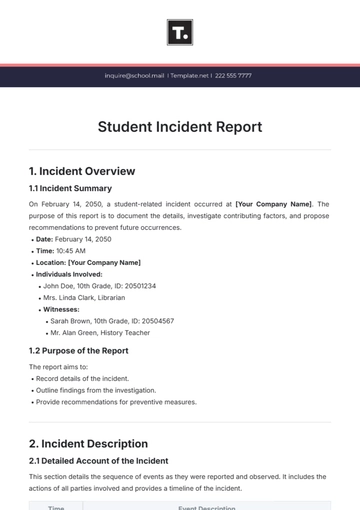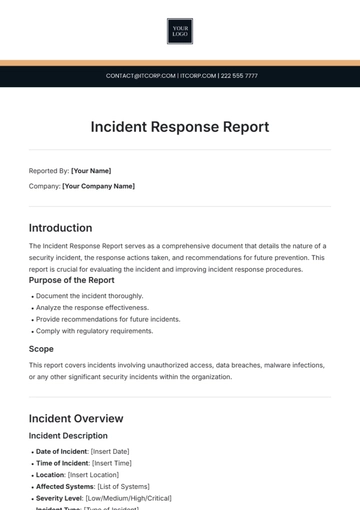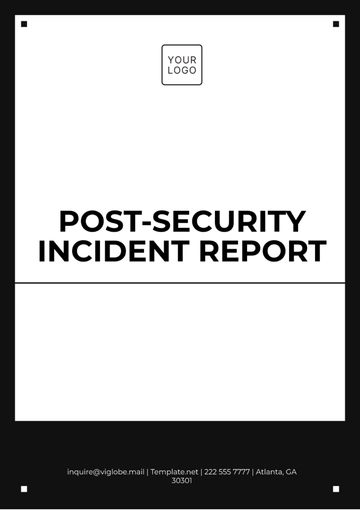Free Mold Incident Report

1. Introduction
This report addresses a recent mold incident discovered within the facility and details the subsequent investigation, remediation efforts, and recommendations for future prevention. The mold incident presented potential risks to the building’s integrity and occupants' health, necessitating immediate and thorough assessment.
2. Incident Overview
Location and Context
Location of Incident:
Building: Northwest Corporate Center
Floor: Lower Level
Room/Area: Storage Room A-12
Environmental Context:
Average Humidity: 65%-75%
Average Temperature: 70°F
Discovery and Initial Assessment
Date Discovered: 06/15/2050
Person(s) Reporting Incident: Jessica Turner, Facility Manager
Initial Signs of Mold:
Visible mold growth on walls and ceilings in the storage room
Damp, musty odor detected by several occupants
Employee complaints of respiratory issues and allergic reactions
Immediate Actions Taken:
Isolated the affected area using temporary barriers
Notified maintenance and safety teams
Conducted a preliminary visual inspection to assess the extent of contamination
3. Health and Safety Impacts
Potential Health Risks
Table 1: Health Risks Associated with Mold Exposure
Symptom or Health Condition | Risk Level | Potentially Affected Individuals |
|---|---|---|
Respiratory issues (e.g., asthma) | High | Occupants with respiratory conditions |
Allergic reactions (sneezing, itching) | Moderate | All building occupants |
Eye irritation | Moderate | All building occupants |
Immune system responses | High | Immunocompromised individuals |
Populations Affected
Total Affected Individuals: 34
Specific Groups:
Facilities management staff working in the affected area
Maintenance personnel who perform routine checks on this floor
Tenant employees who access the area regularly
4. Investigation Findings
Source Identification
Following the initial report, an investigation team was assembled to identify the root cause of the mold growth.
Primary Source: Persistent water intrusion from an exterior wall near the storage room.
Secondary Contributors:
High ambient humidity levels within the facility
Inadequate ventilation in the affected storage room
Environmental and Structural Assessment
Inspection Date: 06/20/2050
Inspection Team:
Peter Williams, Environmental Health Specialist
Luis Fernandez, Structural Engineer
Key Findings:
Water stains and cracks found along the exterior wall, indicating long-term moisture exposure.
HVAC analysis revealed that the ventilation system in this area was underperforming.
Air quality tests confirmed elevated spore concentrations of Stachybotrys and Aspergillus mold.
5. Remediation Efforts
Containment Measures
Area Isolation: The affected storage room was fully sealed using plastic sheeting and HEPA filters to prevent spore spread.
Employee Restrictions: Only remediation-certified personnel were allowed entry until cleanup was completed.
Removal and Cleaning Procedures
Mold Removal: A specialized remediation team employed HEPA vacuums to remove mold from surfaces.
Cleaning Agents Used:
Antifungal and antibacterial solutions applied to all affected surfaces.
A fogging process was employed to disinfect the area thoroughly.
Post-Remediation Testing
Date of Testing: 06/30/2050
Test Results:
Airborne mold spore levels were found to be within acceptable limits.
Surface swab tests indicated a successful removal of all visible mold.
6. Recommendations and Preventative Measures
Maintenance and Monitoring
To prevent future incidents, the following measures are recommended:
Quarterly Inspections: Schedule quarterly environmental health inspections for the building.
Moisture Control Measures: Repair and seal cracks in the exterior wall and apply water-resistant coating.
Ventilation Upgrades: Improve air circulation in the storage room to manage humidity.
Educational Initiatives
Employee Training: Conduct awareness sessions on mold prevention and identification.
Reporting Protocol: Establish a protocol for reporting potential mold signs to facilities management.
7. Conclusion
The incident of mold contamination in the Northwest Corporate Center was thoroughly investigated and remediated with appropriate measures. Preventative steps have been recommended to ensure ongoing safety and health for all building occupants. Continued vigilance and regular monitoring will help prevent similar occurrences in the future.
- 100% Customizable, free editor
- Access 1 Million+ Templates, photo’s & graphics
- Download or share as a template
- Click and replace photos, graphics, text, backgrounds
- Resize, crop, AI write & more
- Access advanced editor
Template.net’s Mold Incident Report Template helps in accurately documenting mold-related incidents. Editable and customizable in our AI Editor Tool, this template allows users to record specific details such as location, affected areas, and remedial actions. Perfect for property management or environmental safety, this template promotes clear, organized reporting to support health and safety standards.
You may also like
- Sales Report
- Daily Report
- Project Report
- Business Report
- Weekly Report
- Incident Report
- Annual Report
- Report Layout
- Report Design
- Progress Report
- Marketing Report
- Company Report
- Monthly Report
- Audit Report
- Status Report
- School Report
- Reports Hr
- Management Report
- Project Status Report
- Handover Report
- Health And Safety Report
- Restaurant Report
- Construction Report
- Research Report
- Evaluation Report
- Investigation Report
- Employee Report
- Advertising Report
- Weekly Status Report
- Project Management Report
- Finance Report
- Service Report
- Technical Report
- Meeting Report
- Quarterly Report
- Inspection Report
- Medical Report
- Test Report
- Summary Report
- Inventory Report
- Valuation Report
- Operations Report
- Payroll Report
- Training Report
- Job Report
- Case Report
- Performance Report
- Board Report
- Internal Audit Report
- Student Report
- Monthly Management Report
- Small Business Report
- Accident Report
- Call Center Report
- Activity Report
- IT and Software Report
- Internship Report
- Visit Report
- Product Report
- Book Report
- Property Report
- Recruitment Report
- University Report
- Event Report
- SEO Report
- Conference Report
- Narrative Report
- Nursing Home Report
- Preschool Report
- Call Report
- Customer Report
- Employee Incident Report
- Accomplishment Report
- Social Media Report
- Work From Home Report
- Security Report
- Damage Report
- Quality Report
- Internal Report
- Nurse Report
- Real Estate Report
- Hotel Report
- Equipment Report
- Credit Report
- Field Report
- Non Profit Report
- Maintenance Report
- News Report
- Survey Report
- Executive Report
- Law Firm Report
- Advertising Agency Report
- Interior Design Report
- Travel Agency Report
- Stock Report
- Salon Report
- Bug Report
- Workplace Report
- Action Report
- Investor Report
- Cleaning Services Report
- Consulting Report
- Freelancer Report
- Site Visit Report
- Trip Report
- Classroom Observation Report
- Vehicle Report
- Final Report
- Software Report





























